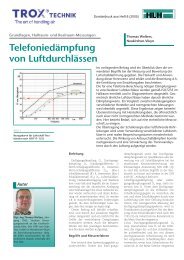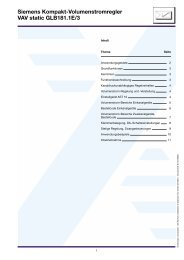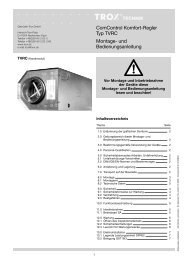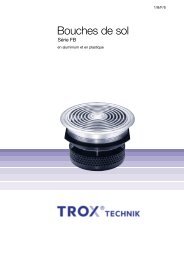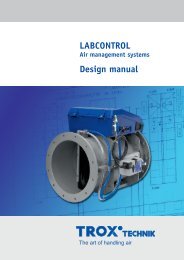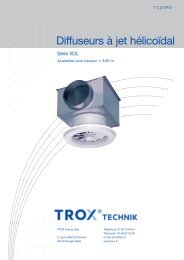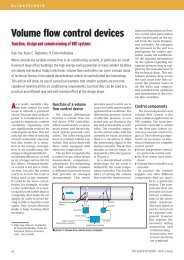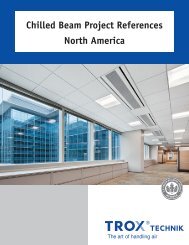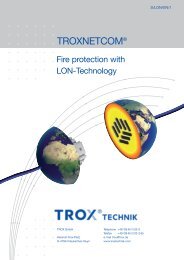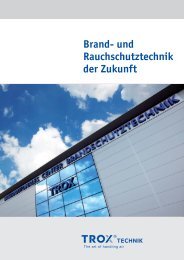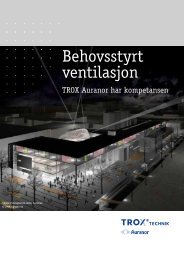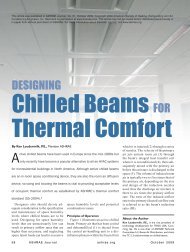You also want an ePaper? Increase the reach of your titles
YUMPU automatically turns print PDFs into web optimized ePapers that Google loves.
Airside <strong>Design</strong> Considerations<br />
Space temperature control in passive beam systems is<br />
accomplished by varying the amount of sensible heat<br />
removed by the chilled water. The chilled water supply<br />
to several beams within a single zone is generally<br />
controlled by a single chilled water valve. Although the<br />
zone may consist of multiple spaces, a certain degree<br />
of temperature compensation for each space will be<br />
affected by the passive beam itself. As the cooling<br />
requirement of the space is reduced, the temperature of<br />
the air entering the beam will also be reduced. This will<br />
result in less heat transfer to the water circuit and a<br />
lower return water temperature.<br />
Passive chilled beams cannot be used for heating as its<br />
airflow would be reversed. They are typically applied<br />
with some type of separate heating system such as low<br />
level finned tube heaters. Radiant (ceiling or wall<br />
mounted) heating panels can also be used depending<br />
on the façade heat losses expected.<br />
Thermal comfort considerations with active beams<br />
While the primary (conditioned) airflow rate for active<br />
chilled beams can be greatly reduced, their induction<br />
ratios (2 to 6 CFM of room air per CFM primary air)<br />
result in discharge airflow rates that are slightly higher<br />
than those of conventional all-air systems. As such,<br />
attention should be exercised in the beam placement to<br />
avoid drafty conditions and maximize occupant thermal<br />
comfort. Figure 19 predicts maximum occupied zone<br />
velocities for various combinations of primary airflow<br />
rates and active beam spacing. This nomograph<br />
suggests local velocities which will maintain acceptable<br />
levels of occupant comfort per ASHRAE.<br />
Active beams can be for heat in moderate climates. Hot<br />
water can either be delivered to each perimeter area<br />
beam or to a hot water heating coil in the duct supplying<br />
a number of beams within the same thermal control<br />
zone. The use of a zone hot water heating coil feeing<br />
multiple chilled beams is a generally more economic<br />
option than piping each chilled beam for heating as it<br />
may save considerable labor and piping material costs.<br />
If active chilled beams are used for heating, the following<br />
recommendations should be observed:<br />
• <strong>Chilled</strong> beam discharge temperatures should<br />
be maintained within 15˚F of the room<br />
temperature.<br />
• Velocities at the mid-level of outside walls and<br />
windows should be maintained within the<br />
region indicated in figure 19.<br />
Unoccupied periods demanding heating via the chilled<br />
beams or primary air system will require that the AHU<br />
remain operational.<br />
Variable air volume operation using active beams<br />
Although normally operated as constant air volume<br />
delivery devices, active chilled beams can also be used<br />
as variable air volume (VAV) devices. VAV operation<br />
may be advantageous when space occupancy and/or<br />
ventilation demands vary widely. Recommendations for<br />
the control of chilled beams in VAV applications can be<br />
found in the control section of this document.<br />
As the room air distribution provided by active<br />
beams is identical to that provided by ceiling slot<br />
diffusers, their selection for (total) discharge airflow<br />
rates greater than 40 CFM per linear foot of slot is<br />
not recommended when high levels of occupant<br />
thermal comfort are required!<br />
The v L velocities shown in figure 19 are those predicted<br />
within 2 inches of the window or wall surface during<br />
cooling operation. It is recommended that beams which<br />
are configured for both heating and cooling of perimeter<br />
spaces be selected such that v L (selected for cooling<br />
operation) is between 120 and 150 FPM in order to<br />
assure that the warm air is adequately projected down<br />
the perimeter surface. Velocities taken 6 inches away<br />
from the surface can be expected to be about half those<br />
values.<br />
Heating in chilled beam applications<br />
Ceiling or high sidewall mounted passive chilled beams<br />
exert no motive force on their discharge airflow, and<br />
cannot be used for overhead heating. Heating must be<br />
provided by a separate source, either the primary air<br />
supply or a separate heating system (finned tube,<br />
radiant panel, etc.).<br />
17





